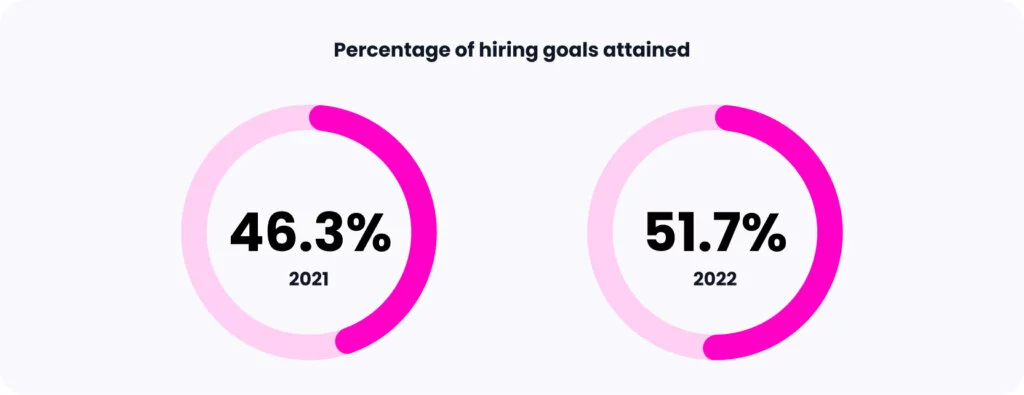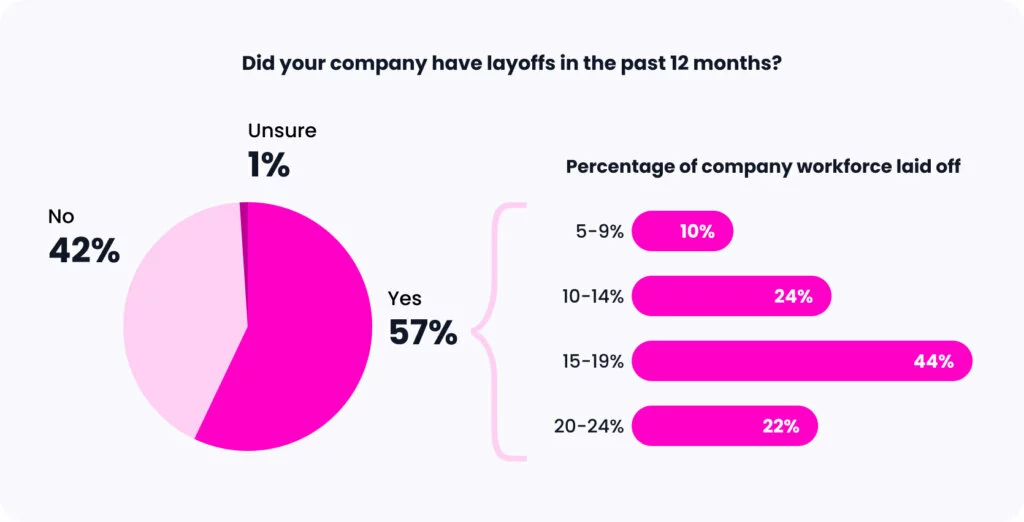Table of Contents
It’s almost becoming a joke — “do more with less.” It’s basically the mantra of the tech world right now, but it’s rare that anyone tells us what it actually means. We do know budgets are tighter. We know teams have been reduced. And we know that making the best possible hire is more important than ever.
So we spoke with the experts to go beyond “do more with less” and reveal real, practical ways that tech hiring teams can hit their goals in the midst of tech hiring challenges. Watch the full conversation below or keep reading for the key takeaways.
Introducing the experts:
- Ahryun Moon is Co-Founder & Head of Company Strategy at GoodTime. As the leader of a company that helps teams hire 50% faster by automating interview scheduling, she has deep insight into the importance of digital transformation in recruiting.
- Amanda Richardson is the CEO and Head of People at CoderPad. With a background in product management, Amanda’s focus at CoderPad is on enhancing the hiring process for technical roles.
- Jenny Jongejan is a Senior Recruiting Consultant. With 17 years of talent acquisition experience, Jenny has worked extensively with Bay Area startups, enabling efficient, standardized processes.
Unlock 2024’s top hiring strategies: Insights from 500+ TA leaders
Discover proven solutions to 2024’s biggest hiring challenges – straight from the highest-performing TA teams.
Shifting priorities in tech recruitment
One of the most significant challenges facing tech recruiting teams is the need to adapt to constantly changing priorities. Just in the past couple of years, tech recruiters have dealt with explosive hiring, then the great reshuffle, then hiring freezes and team reductions. As the economic landscape fluctuates, teams must remain flexible, adapt to leaner budgets and smaller teams, and be prepared for still more changes in the future.
Our Technology Hiring Insights Report showed that on average, tech teams are hitting just around half of their hiring goals.

Ahryun Moon summarized the current tech hiring landscape: “With some layoffs and a downturn in the economy recently, the recruiting teams have received a big blow. Team size is getting much smaller than before, but quite a lot of recruiters are still being told to hit pretty lofty recruiting goals. A lot of recruiters are also becoming full cycle, without RC support, so they’re doing the entire process. That’s why a lot of teams are looking into automation and AI.”
Indeed, layoffs hit tech recruiting teams particularly hard this year. Our Hiring Insights Report found that 44% of companies had cuts that affected 15-19% of their headcount, and 22% reduced over 20% of their company’s total workforce.

Ahyun emphasizes that digital transformation has long been an aspirational talking point for companies, but in the “do more with less” era, it’s become a must-have, where recruiting teams are charged with bringing in crucial technology to fill in new gaps.
Standardization and automation: the dynamic duo to address tech hiring challenges
In the wake of tech’s hiring challenges, standardization and automation have emerged as essential priorities for tech recruiting teams.
Amanda Richardson defines these concepts for us: “Standardization is doing the same thing, having a standardized process. Automation is about making that process more efficient — whether that’s with scheduling or assessments — whatever tooling you can use to do the same repeated tasks more efficiently.”
Having clearly defined and standardized processes in place is crucial before you can effectively automate.
Jenny Jongejan, a seasoned talent acquisition expert, shares her four-step framework for an effective standardized recruitment process. She says when you’re standardizing, it’s important to first become crystal clear on:
- Why you’re hiring: What objective is this role going to impact?
- Who you’re hiring: What skills and experiences and behavioral attributes do you need?
- How you’ll assess the candidate: For each stage in your interview process, how will you determine if the candidate is a fit?
- Your evaluation criteria: How will you define what an okay answer looks like versus a great answer?
“I know that sounds prescribed,” Jenny acknowledges, “but research does show that structured interviews are 81% more accurate in predicting job performance than unstructured ones.”
Learn more about behavioral interview techniques and interviewer training.
The role of AI and automation
There’s a reason why recruiting AI and automation are taking the spotlight. Ahryun stresses the importance of leveraging tech recruiting software to optimize the recruitment journey with limited resources: “There’s a lot of different places in the process that we can automate all the way from the top of the recruiting funnel to the middle and bottom. At the top of the funnel, there’s candidate nurturing. Tools like ChatGPT can help you with the content side of that. At the middle of the funnel, definitely interview scheduling. And at the bottom of the funnel, there’s background checks and onboarding.”
Remember: AI won’t replace human recruiters. Rather, leveraging basic AI tools can help with personalization and initial communication with candidates, providing time-saving and efficient solutions for recruiters. Those wishing to cut their middle- and bottom-of-the-funnel efforts in half, without sacrificing the quality of their process, can find immense ROI in AI-based scheduling, assessment, and onboarding tools.
Balancing candidate experience, personalization, and efficiency
In today’s leaner economic environment, tech recruiters often struggle to balance personalization and efficiency in their processes. While automation and standardization offer efficiency gains, personalization remains vital in creating a positive candidate experience.
Jenny emphasizes the significance of personalizing outbound communication: “Knowing your candidate profile and personalizing the message in a way that is going to tug on somebody’s individual heartstrings […] is going to actually get more quality candidates into the top of the funnel.”
The role of candidate experience in a lean market
TA leaders agree with Jenny. In our own poll, 85% of respondents said candidate experience is still a priority in today’s market, with 59% saying it’s actually more important than ever before.

The experts on our webinar emphasized the importance of transparency throughout the hiring process, starting from the job posting itself. By providing detailed information about compensation, benefits, and the hiring timeline, candidates have a clearer understanding of what to expect, and it starts the process off on the right foot.
Amanda also shares one of our favorite quick tips for improving candidate experience: “I would challenge every recruiter to apply to a job on their website and then apply to a job on their competitor’s website.”
She recommends as you go through both processes, ask yourself:
- Is this interesting?
- How does it feel?
- Is the experience smooth and easy to navigate?
- Does it feel like you’re being treated as one in a million or like one in a herd of cattle?
“Just spend the time going through and understand what your process is already and you will immediately find ways to improve your candidate experience,” she says.
A holistic approach to quality of hire
In lean times, hiring decisions become even more crucial. Ahryun emphasizes this point: “With the number of candidates in the market now, every single hire that you make actually becomes even more important.” Standardized processes, personalized engagement, and leveraging AI-driven tools all contribute to enhancing the quality of your hires, but all of these efforts need to work holistically and cohesively together.
Setting clear criteria for tech roles
Defining clear evaluation criteria is crucial to ensure that everyone involved in the hiring process is on the same page.
Ahryun stresses the importance of an intake meeting and highlighted the value of having a shared understanding of the definition of a “top performer” from the very beginning of the hiring process. By collaboratively defining the standards for quality hires, recruiting teams can mitigate the temptation to compromise quality for quantity. Amanda adds, “Being transparent and clear along the way really goes a long way to align the recruiting team and the business team around what our objectives are.”
Jenny emphasizes the significance of standardized, fair questions in accurately evaluating candidates’ fitness for a role: “Implementing an assessment tool that is fair versus asking questions that may be more gotcha questions or have more subjective answers is going to help improve your process significantly.”
Minimizing mis-hires with smart standardization
Mis-hires can be costly and detrimental to a company’s growth. To avoid them, tech recruiting teams must focus on standardized processes and structured interviews.
Amanda doubles down on standardization as a way to prevent mis-hires, saying, “Having a standardized process is incredibly hard. It sounds easy, but really forcing people to ask candidates the same questions in the same order every time is really hard. But that, to me, will actually solve a lot of the mis-hires.”
Unlock tech’s top hiring strategies in 2024
Our study of 100 tech TA leaders reveals how to hit your hiring goals in a challenging market.
Predicting the future of tech hiring
Given the uncertainties of the economic landscape, it’s difficult to speculate on when hiring might regain its momentum. Still, Ahryun makes a data-informed guess on when we might see another hiring boom:
“Hiring will pick back up when we think the economy will pick back up. Unemployment is still low, and inflation has been tamed. We are already actually seeing from our interview data an uptick from a lot of companies, so it seems like that positivity and optimistic feeling about the future is starting to come back.”
Better tech recruitment now and in the future
To successfully address tech hiring challenges now, and into the future, teams must prioritize clarity in their process and value in their tech stack — in that order. Here’s a roundup of the must-knows from our panel discussion:
- Standardization and automation work together to streamline processes and enhance hiring efficiency.
- Adaptability remains crucial amid changing priorities and economic fluctuations.
- Embrace digital transformation and harness AI to bridge resource gaps.
- Candidate experience still matters, and can actually be improved through standardization.
- Transparent communication (internally and externally) and holistic assessment foster quality hiring.
By integrating these takeaways, tech recruiting teams can chart a course toward success, adeptly managing challenges in an ever-evolving industry.






